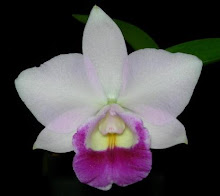There's a bit of a learning curve with the Adgia Test strips. I thought I had some sort of rudimentary lab skills left over from my college days, but I guess not. Nevertheless I've managed to test some of my suspicious orchids as well as the non-suspicious ones I'm giving away. Only one 'suspect' showing color break was infected. Remember there are a myriad of viruses out there, these strips only check for two, Cymbidium Mosaic Virus (CymMV) and Odontoglossum Ring Spot Virus (ORSV).
I blew through 3-4 tests before I got the knack of not vigourously crushing the sample in the meshed reagent bag such that a frothy liquid was the result. It was almost impossible to dip the immunostrip to the proper depth amongst the froth. Waiting for the froth to clear didn't help as the sample oxidizes quickly. Neither the Adgia web page nor the 'Orchids' article on these tests mention either the froth or the oxidation. So I'm mentioning it here. If you rub the tissue sample as vigourously as is shown in the Adgia training video you'll get a sample that resembles beer and is hard to dip the immunostrip into - yeilding an improper test result and wasting a test kit. Don't make my same mistake.
For future reference the article in 'Orchids' magazine is in the May 2008 edition, written by Loren Batchman on page 343. Nice article.
Jodi Hirt mentioned that Bruggsmansia (I know I spelled that wrong) can be used as an indicator plant. Cheaper than strips takes a few days for the Bruggs to react, but hey, it works for her. The idea is to abrade a leaf of the Bruggsma-er-whatever plant with sandpaper then rub a cut piece from the suspicious orchid on it, getting the 'juice' onto the leaf. Wait a few days and the leaf will change if its virused. I have no idea why this doesn't also infect the whole Bruggs plant. But there you go.
Subscribe to:
Post Comments (Atom)

No comments:
Post a Comment